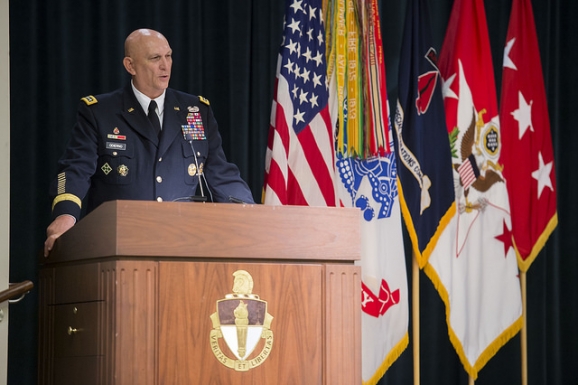 From Julian E. Barnes, Wall Street Journal: The head of the Army said on Friday that he was taking steps to offset the continuing reduction of U.S. forces in Europe, moves that would allow the U.S. to rotate additional forces to the region more easily, and, in times of crisis, reinforce units in Eastern Europe.
From Julian E. Barnes, Wall Street Journal: The head of the Army said on Friday that he was taking steps to offset the continuing reduction of U.S. forces in Europe, moves that would allow the U.S. to rotate additional forces to the region more easily, and, in times of crisis, reinforce units in Eastern Europe.
Gen. Ray Odierno, chief of staff of the Army, said in an interview with The Wall Street Journal that he wants to put in position an additional brigade’s worth of heavy equipment,including tanks and armored-personnel carriers, in Germany. That would allow units to deploy to Europe more quickly in a crisis, he said.
Army plans would supplement a decision, announced last week by Defense Secretary Ash Carter, to build up smaller sets of equipment in Eastern Europe.
While the equipment in Eastern Europe would be used regularly by smaller units for training exercises, the larger stockpile of heavy equipment in Germany would more likely be used for a crisis, Army officials said. That would allow a heavy brigade of some 3,500 soldiers to fly quickly to Europe.
Gen. Odierno said he also intends to designate the entire Colorado-based 4th Infantry Division as a so-called regionally aligned force for Europe. Such a designation would mean the division’s brigades, helicopters and logistics specialists would regularly deploy to Europe to conduct security exercises.
Currently, the Army has one brigade [1st Armored Brigade Combat Team, 3rd Infantry Division] based in the U.S. state of Georgia that is aligned to Europe. The new plan,which would be implemented over the next two years, would allow more soldiers to be available for operations and exercises in Europe. It would also allow the division’s intelligence experts to focus on the threat from Russia and its planners to become experts on allied capabilities….
[Vice President of the Center for Strategic and International Studies Heather] Conley said Gen. Odierno’s moves should be praised, but the Pentagon needs to do a comprehensive evaluation of all of its forces in Europe and decide if it needs to push more units further east. “Do we want to be reactive or do we want to have a forward-deployed deterrent that will send a clear message,” Ms. Conley said.
From Michelle Tan, Army Times: These moves come as the Army continues a massive drawdown of forces that has already cut 10,000 soldiers — including two brigade combat teams — from Europe. Another 1,700 soldiers will be cut over the next three years as part of the latest round of reductions, leaving about 30,000 soldiers forward-stationed in Europe….
There is “a growing recognition that this is not a spike in bad behavior by President Putin, but that this represents a much longer term set of challenges that we’re going to deal with,” Lt. Gen. Ben Hodges, commander of U.S. Army Europe, said Monday during a meeting with reporters at the Pentagon….
The Army also began building a brigade-sized set of equipment in Europe for use by regionally-aligned forces sent to the region for Operation Atlantic Resolve and other exercises and training events with partner nations. Known as the European Activity Set, the equipment will be split into several countries, including the three Baltic States, Poland, Bulgaria, Romania and Germany, for regular use by incoming rotational forces.
Most of the equipment — about 1,200 vehicles in all, including about 220 tanks, Bradleys and Howitzers — should arrive in Europe by December, Hodges said….
While the equipment is expected to arrive by the end of the year, the various host nation sites likely won’t all be ready until summer 2016, Hodges said. Until then, some of the EAS will be stored in Coleman Barracks in Mannheim, Germany.The second set of equipment, known as Army Prepositioned Stocks, would be reserved for contingencies….
The U.S. also has committed, in the coming year, to providing an attack helicopter battalion to serve on the Very High Readiness Joint Task Force, or VJTF, a new quick-reaction force that came out of the September NATO summit in Wales.
Image: US Army Chief of Staff, Gen. Ray Odierno, July 1, 2015 (photo: Sgt. Chuck Burden/Department of Defense)

